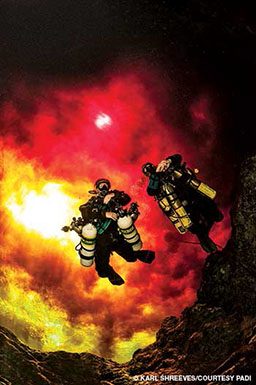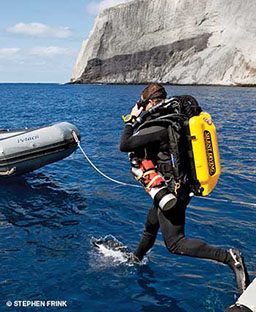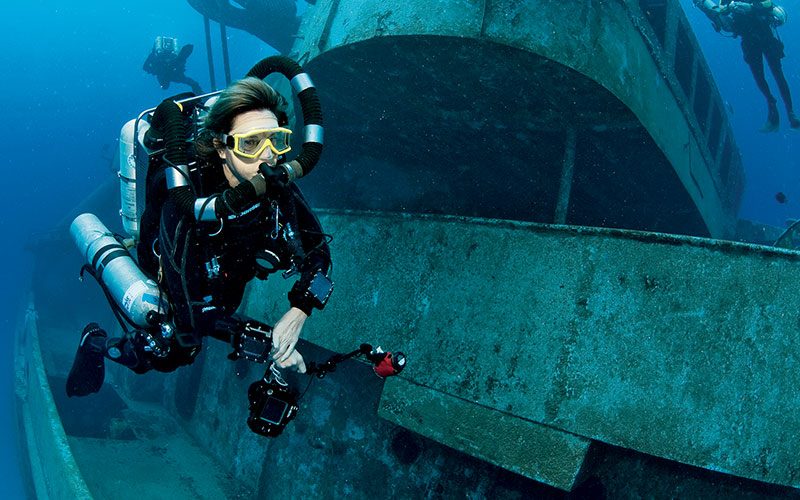You know tech divers. They’re the gearheads with double cylinders or rebreathers, multiple deco cylinders of synthetic gases and enough computers to fly the space shuttle. As if all that weren’t cool enough, their drysuits have pee valves. Tech divers (a.k.a. “tec divers,” “technical divers” or “dropped-on-head-as-infant divers”) are all about dives that are deeper and longer than those made in mainstream recreational diving.
Why Do It?
There are probably as many reasons to do it as there are tech divers, but you’ll hear these explanations often:
- EXPLORATION. It’s a privilege to go where few people do or, even better, where you can be first. Tech diving lets you do this.
- ACCOMPLISHMENT. Anything worth doing takes training, time, commitment and discipline. There’s an undeniable sense of achievement when 100 feet is a decompression stop rather than the dive’s deepest depth.
- ADRENALINE. Tech diving isn’t for thrill seekers, but you have to be emotionally dead not to feel something while exploring a virgin underwater cave 2,000 feet from the closest exit.
- CONTRIBUTION. Early cave divers created the octopus and first embraced enriched air nitrox. Tech divers are some of the “test pilots” for new technologies that may eventually become mainstream.
- PERSPECTIVE. T.S. Eliot put it this way: “We shall not cease from exploration, and the end of all our exploring will be to arrive where we started and know the place for the first time.”
Types of Tech Diving
Let’s start with a definition. Generally, tech diving is diving — other than commercial, military or public safety diving — that takes divers beyond the limits of mainstream recreational diving by using more extensive training and technologies to manage the risks. It includes decompression diving, diving deeper than 130 feet, wreck or cave penetration beyond 130 linear feet from the surface and using comparatively complex methods and equipment to enhance underwater performance.
There are various tech-diving disciplines. Broadly, they can be categorized in terms of depth and distance.

Depth — Tech diving is pushing deeper and deeper: 200 feet is an intermediate training dive, and 300 feet is not unusual. Very experienced tech divers now dive to 600 feet. To about 300 feet, tech divers can use open-circuit equipment — typically four to six cylinders with various gas mixes to reduce oxygen toxicity risk, manage gas narcosis and optimize decompression
In open-circuit diving, deeper depths mean faster gas consumption. Carrying enough gas becomes increasingly cumbersome and expensive, so below 300 feet (and increasingly, below 200 feet) closed-circuit rebreathers (CCRs) have become the first choice. CCRs recycle breathing gas, which saves a lot compared to open-circuit, and they adjust the gas mix so it is optimized to the diver’s present depth. A brief dive to 300 feet would consume more than 140 cubic feet of gas on open-circuit scuba but less than 5 cubic feet with a CCR.
With either technology, the main “deep gas” is trimix, a blend of oxygen, helium and nitrogen. Helium is used because it’s nonnarcotic and less dense than oxygen and nitrogen, which means reduced breathing effort at depth. A common trimix at 300 feet, for example, is TMx10.5/50 — 10.5 percent oxygen, 50 percent helium and the balance nitrogen. This gas cannot support life at the surface and thus requires special handling considerations.
For decompression, tech divers use trimix, enriched air nitrox and/or pure oxygen. As they ascend, open-circuit divers progressively switch to cylinders with higher percentages of oxygen and lower percentages of helium and/or nitrogen. CCRs raise the proportion of oxygen in the breathing gas. Both of these methods make for more efficient (i.e., quicker) decompression. High-oxygen gases are toxic at depth, so tech divers follow special procedures to prevent breathing the wrong gas, which can be, and has been, fatal.

Distance — Tech diving also pushes limits horizontally, mainly in cave diving. Tech divers go thousands of feet into caves using open-circuit scuba. The technique they use is to wear “stage” cylinders, use one-third of the gas in each, switch to the next and then secure the used cylinder for retrieval while exiting. This continues until the divers leave their last stage behind and the team explores using its main cylinders (at least two cylinders with two independent regulators). With four stages (six cylinders total) cave divers can get more than half a mile in before turning for home.
As distances get longer and depths deeper, carrying gas becomes a challenge, especially when decompression is part of the dive. Leading-edge divers may use large diver propulsion vehicles (DPVs, or scooters) to tow them along with more cylinders than they could swim with. Alternatively, support divers might place full stage cylinders in the cave so “push” divers can exchange used for fresh and go farther. Open-circuit will likely remain dominant in cave diving, but CCRs are becoming popular for accommodating distance as well as depth.
Differing depths, distances, technologies and environments combine into different types of tech, such as deep trimix wreck diving using open-circuit gear or long-range exploratory cave diving with CCRs.
Comparative Risk
Is tech diving riskier than mainstream recreational diving? Absolutely. If you have an hour of decompression or you’re in a cave, you can’t ascend immediately in the event of a problem. This alone adds risk. Tech diving also has more inherent risk due to complexity of equipment and procedures. The chain of errors leading to a serious accident is much shorter than in recreational diving.
Tech divers manage this risk with added equipment (at least two independent life-support systems at all times) coupled with more stringent training and a deeper understanding of the risks. Dive incident statistics suggest that tech divers manage the added risk rather well. But while the incident rate is low, it is not as low as in recreational diving. If you take up tech diving, you must accept that you are taking on more risk.

Tech Configurations
There are three basic tech-diving configurations.
BACKMOUNT OPEN CIRCUIT: The original tech setup; the modern configuration consists of:
- Double cylinders with a valve that accepts two independent DIN regulators. You can shut down either and access the remaining gas from the other. In deep diving, your doubles hold your main (“deep”) gas.
- One or more stage/deco cylinders. (Stage cylinders extend bottom time; deco cylinders hold decompression gas). All are marked with the gas they contain and its maximum breathable depth.
- Harness and rear wing-style BCD
SIDEMOUNT OPEN CIRCUIT: Originally for diving in small caves, sidemount uses single cylinders mounted on the diver’s sides. It is becoming more popular in open-water because of some of its cylinder-handling benefits.
- Two main single cylinders, one per side. These stay with you at all times.
- Stage/deco cylinders
- A special sidemount harness and BCD
CLOSED CIRCUIT: Tech diving requires manually operated rebreathers. Some rebreathers are always manual (mCCRs); others automatically control functions (eCCRs) but allow manual operation in contingency situations.
- One or more open-circuit bailout bottles. These contain enough bailout gas to allow the diver to safely reach the surface, but they’re used only if the CCR fails. The deeper or more distant the dive, the more bailout required.
- Off-board gas supply (additional rebreather gas stored externally to the unit)
- Most CCRs have unit-specific BCDs and harnesses.
Becoming a Tech Diver
Tech diving commonly requires multiple qualifications. For example, cave diving to 400 feet using a CCR requires qualifying in CCR diving, the particular CCR used, cave CCR diving, at least three levels of deep CCR diving and drysuit diving. The certifying organizations have different levels, but here’s an overview:
Prerequisite: Tech divers begin as recreational divers with at least some training beyond entry-level, including basic enriched air nitrox.
Open-Circuit Deep
- First level — Backmount or sidemount with one or two deco cylinders for air/enriched air nitrox decompression diving to the 130-foot range
- Second level — Trimix and multiple deco gases to the 200-foot range
- Third level — Hypoxic trimix (not breathable at the surface) and deco gases to the 300-foot range
Closed-Circuit Deep
- First level — Using a tech CCR with a bailout for primarily no-decompression diving to the 130-foot range
- Second level — Using a tech CCR with trimix and two bailout cylinders to the 200-foot range
- Third level — Using a tech CCR with hypoxic trimix and three or more bailout cylinders to the 300-foot range
- Fourth level — Exploratory CCR below the 300-foot range (very few divers qualify to this level)
Cave Diving
- Cavern — Using standard recreational equipment in the cavern zone (within 130 feet of and within sight of light from the surface)
- Level one — Using full or partial cave gear beyond the cavern zone but within the range of a single cylinder
- Level two — Using full cave gear and diving within the range of double cylinders
- Level three — Using stage cylinders to extend range
Technical Wreck Diving
- Level one — Penetrating wrecks (similar to cave diver training)
- Level two — Penetrating deep wrecks (deep tech diving is usually a prerequisite)
Is it Right For You?
You can be a serious, gung-ho diver and have loads of adventures within the realm of mainstream recreational diving. Tech diving is not for everyone, and it shouldn’t be seen as a desirable goal for every diver.
If you think it may interest you, learn more about the risks, equipment and training involved. Look for structured, integrated and comprehensive training with an experienced instructor. Respect your limits. (Be patient, your limits will grow as you progress through the required training and gain experience). Finally, accept the risks and responsibilities. Tech diving demands commitment and dedication and raises the potential risks. If you can’t or won’t accept these, tech diving isn’t for you.
© Alert Diver — Q1 Winter 2014